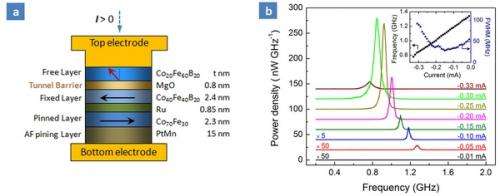Research team develops new compact and energy-efficient nanoscale microwave oscillators

By using improved magnetic materials, based on the control of interface properties of ultra-thin magnetic films, researchers from the Suzhou Institute of Nano-tech and Nano-bionics, Chinese Academy of Sciences (SINANO), the University of California at Los Angeles(UCLA), and the University of Messinahave made major experimental improvements to develop a more compact, more energy-efficient generation of a mobile communication device known as spin transfer nano-oscillator (STNO). STNOs use the spin of electrons to create steady microwave oscillations needed for various applications in mobile communications, unlike current silicon-based oscillators which use their charge. The SINANO team's improved oscillator has great potential to be used in future portable electronic devices and wireless modules, systems on a chip, and for power-efficient local clock signal generation in digital systems.
The STNOs are composed of two distinct magnetic layers. One layer has a fixed magnetic polar direction, while the other layer's magnetic direction can be manipulated to gyrate by passing an electric current through it. This allows the structure to produce very precise oscillating microwaves. The STNO's key advantage over existing technologies is that it can combine large tunability and low energy with nanoscale size, as well as broad working temperature ranges.
Yet while STNOs are potentially superior in many respects to existing microwave oscillator technologies, their microwave signals mainly rely on both large drive currents and the application of external magnetic fields, which hinders the implementation of STNOs for practical applications in terms of power dissipation and size.
By using magnetic layers with perpendicular magnetic anisotropy– similar to those used in spin-transfer torque memory – the SINANO team demonstrated large microwave signals at ultralow current densities (<5.4×105A/cm2) and in the absence of any bias magnetic fields. This eliminates the need to move large numbers of electrons through wires, and also eliminates the need for permanent magnets or conducting coils to provide the bias magnetic field, thus significantly saving both energy and space. The results are microwave oscillators that generate much less heat due to their lower current, making them more energy-efficient.
"Previously, there had been no demonstration of a spin-transfer oscillator with sufficiently high output power, low drive current density, and simultaneously without the need for an external magnetic field, hence preventing practical applications," said the lead researcher ZENG Zhongming, SINANO professor at the SINANO Nanofabrication Facility. "We have realized all these requirements in a single device."
"The ability to excite microwave signals at ultralow current density and in zero magnetic field is exciting in nano-magnetism. This work presents a new route for the development of the next-generation of on-chip oscillators." said co-author G. Finocchio, who is an assistant professor at the University of Messina, Italy.
"Ultra-low-power spintronic devices have the potential to transform the electronics industry, with the most immediate example being in the area of nonvolatile magnetic memory (MRAM). This work shows that similar materials and devices may also bring nanoscale spintronic oscillators one step closer to reality," said Pedram Khalili, a research associate and program manager at UCLA and co-author of the paper. "Thesedevices can be integrated with standard CMOS logic manufacturing processes, enabling a wide range of products from standalone memory and microwave components to systems on a chip."
More information: The paper, "Ultralow-current-density and bias-field-free spin-transfer nano-oscillator," has been published online in the journal Scientific Reports (Nature Publishing Group). www.nature.com/srep/2013/13031 … /full/srep01426.html
Journal information: Scientific Reports
Provided by Chinese Academy of Sciences



















